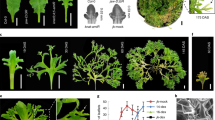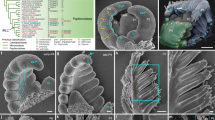Abstract
Pisum sativum L., the garden pea crop plant, is serving as the unique model for genetic analyses of morphogenetic development of stipule, the lateral organ formed on either side of the junction of leafblade petiole and stem at nodes. The stipule reduced (st) and cochleata (coch) stipule mutations and afila (af), tendril-less (tl), multifoliate-pinna (mfp) and unifoliata-tendrilledacacia (uni-tac) leafblade mutations were variously combined and the recombinant genotypes were quantitatively phenotyped for stipule morphology at both vegetative and reproductive nodes. The observations suggest a role of master regulator to COCH in stipule development. COCH is essential for initiation, growth and development of stipule, represses the UNI-TAC, AF, TL and MFP led leafblade-like morphogenetic pathway for compound stipule and together with ST mediates the developmental pathway for peltate-shaped simple wild-type stipule. It is also shown that stipule is an autonomous lateral organ, like a leafblade and secondary inflorescence.





Similar content being viewed by others
Abbreviations
- AF, af:
-
AFILA
- AS1:
-
ASYMMETRIC LEAVES1
- COCH, coch:
-
COCHLEATA
- CRI:
-
CRISPA
- FLO:
-
FLORICAULA
- LFY:
-
LEAFY
- MFP:
-
MULTIFOLIATE-PINNA
- PSKN1:
-
Pisum sativum KNOX1
- PSKN2:
-
Pisum sativum KNOX2
- ST, st:
-
STIPULE REDUCED
- STP, stp:
-
STAMINA-PISTILLOIDA
- TL, tl:
-
TENDRIL-LESS
- UFO:
-
UNUSUAL FLORAL ORGANS
- UNI, uni:
-
UNIFOLIATA
- UNI-TAC, uni-tac:
-
UNIFOLIATA TENDRILLED ACACIA
References
Barkoulas M, Galinha C, Grigg SP, Tsiantis M (2007) From genes to shape: regulatory interactions in leaf development. Curr Opin Plant Biol 10:660–666
Blixt S (1967) Linkage studies in Pisum VII. The manifestation of the genes cri and coch, and the double-recessive in Pisum. Agric Hort Genet 25:131–144
Blixt S (1972) Mutation genetics in Pisum. Agric Hort Genet 30:1–293
Champagne C, Sinha N (2004) Compound leaves: equal to sum of their parts. Development 131:4401–4412
Champagne CEM, Goliber TE, Wojciechowski MF, Mei RW, Townsley BT, Wang K, Paz MM, Geeta R, Sinha NR (2007) Compound leaf development and evolution in the legumes. Plant Cell 19:3369–3378
de Vilmorin P, Bateson W (1911) A case of gametic coupling in Pisum. Proc Royal Soc Lond Ser B Biol Sci 84:9–11
Goldenberg JB (1965) Afila, a new mutation in pea (Pisum sativum L.). Boletin Genet 1:27–31
Gourlay CW, Hofer JMI, Ellis THN (2000) Pea compound leaf architecture is regulated by interactions among the genes UNIFOLIATA, COCHLEATA, AFILA and TENDRIL-LESS. Plant Cell 12:1279–1294
Hofer J, Turner I, Hellens R, Ambrose M, Mathews P, Michael A, Ellis N (1997) UNIFOLIATA regulates leaf and flower morphogenesis in pea. Curr Biol 7:581–587
Hofer J, Gourlay C, Michael A, Ellis THN (2001) Expression of a class I knotted-1 like homeobox gene is down-regulated in pea compound leaf primordia. Plant Mol Biol 45:387–391
Kaplan DR (2001) Fundamental concepts of leaf morphology and morphogenesis: a contribution to the interpretation of molecular genetic mutants. Int J Plant Sci 162:465–474
Kidner CA, Timmermans MCP (2007) Mixing and matching pathways in leaf polarity. Curr Opin Plant Biol 10:13–23
Kujala V (1953) Felderbse bie welcher die ganze Blattspreite in Ranken umgewandelt ist. Arch Soc Zoo Bot Fennicae ‘Vanamo’ 8:44–45
Kumar S, Rai SK, Pandey-Rai S, Srivastava S, Singh D (2004) Regulation of unipinnate character in the distal tendrilled domain of compound leaf-blade by the gene MULTIFOLIATE PINNA (MFP) in pea Pisum sativum. Plant Sci 166:929–940
Lamprecht H (1933) Ein unifoliata—Typus von Pisum mit gleichzeitiger Pistilloidie. Hereditas 18:56–64
Marcotrigiano M (2001) Genetic mosaics and the analysis of leaf development. Int J Plant Sci 162:513–525
Marx GA (1987) A suite of mutants that modify pattern formation in pea leaves. Plant Mol Biol Rep 5:311–335
Micol JL, Hake S (2003) The development of plant leaves. Plant Physiol 131:389–394
Mishra RK (2008) Genetic mapping of LEAF-LET DEVELOPMENT (LLD) and MULTIFOLIATE PINNA (MFP) genes in pea Pisum sativum. PhD Thesis, Devi Ahilya University, Indore, India
Mishra RK, Chaudhary S, Kumar A, Kumar S (2009) Effects of MULTIFOLIATE-PINNA, AFILA, TENDRIL-LESS and UNIFOLIATA genes on leafblade architecture in Pisum sativum. Planta. doi:10.1007/s00425-009-0931-5
Pellew C, Sverdrup A (1923) New observations on the genetics of peas (Pisum sativum). J Genet 13:125–131
Prajapati S, Kumar S (2001) Role of LLD, a new locus for leaflet/pinna morphogenesis in Pisum sativum. J Biosci 26:607–625
Prajapati S, Kumar S (2002) Interaction of the UNIFOLIATA-TENDRILLED ACACIA gene with AFILA and TENDRIL-LESS genes in the determination of leafblade growth and morphology in pea Pisum sativum. Plant Sci 162:713–721
Rutishauser R, Isler B (2001) Developmental genetics and morphological evolution of flowering plants, especially bladderworts (Urticularia): Fuzzy Arberian morphology complements classical morphology. Ann Bot 88:1173–1202
Sharma B (1981) Genetic pathway of foliage development in Pisum sativum. Pulse Crops Newslett 1:26–32
Tattersall AD, Turner L, Knox MR, Ambrose MJ, Ellis THN, Hofer JMI (2005) The mutant crispa reveals multiple roles for PHANTASTICA in pea compound leaf development. Plant Cell 17:1046–1060
Taylor S, Hofer J, Murfet I (2001) Stamina pistilloida, the pea ortholog of Fim and UFO, is required for normal development of flowers, inflorescences and leaves. Plant Cell 13:31–46
Tsukaya H (2005) Leaf shape: genetic control and environmental factors. Int J Dev Biol 49:547–555
Villani PJ, DeMason DA (1997) Roles of the Af and Tl genes in pea leaf morphogenesis: characterization of the double mutant (af af tl tl). Am J Bot 84:1323–1336
Wiltshire RJE, Murfet IC, Reid JB (1994) The genetic control of heterochrony: evidence from developmental mutants of Pisum sativum L. J Evol Biol 7:447–465
Yaxley JL, Jablonski W, Reid JB (2001) Leaf and flower development in pea (Pisum sativum L): mutants cochleata and unifoliata. Ann Bot 88:225–234
Acknowledgments
Grateful thanks are due to the Director, NIPGR for facilities, Indian National Science Academy for grant of an INSA Senior Scientist scheme to SK and S.K. Rai, Sunil Kumar and Vinod Kumar for help in field work and to Ashverya Laxmi for reading the manuscript.
Author information
Authors and Affiliations
Corresponding author
Rights and permissions
About this article
Cite this article
Kumar, S., Mishra, R.K., Kumar, A. et al. Regulation of stipule development by COCHLEATA and STIPULE-REDUCED genes in pea Pisum sativum . Planta 230, 449–458 (2009). https://doi.org/10.1007/s00425-009-0952-0
Received:
Accepted:
Published:
Issue Date:
DOI: https://doi.org/10.1007/s00425-009-0952-0




